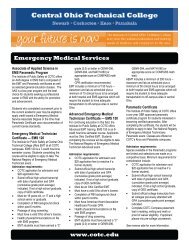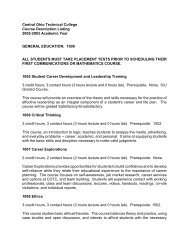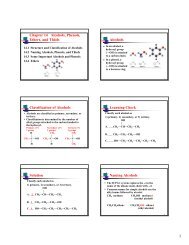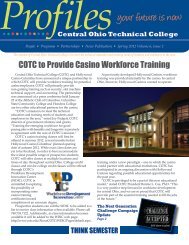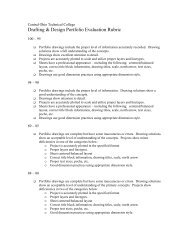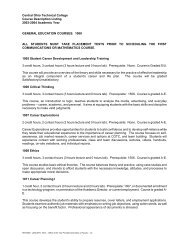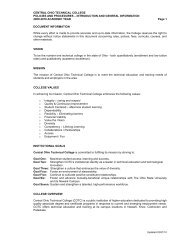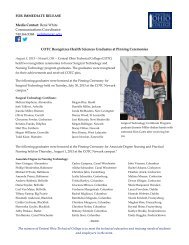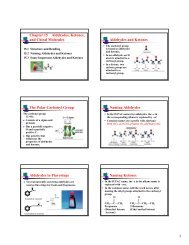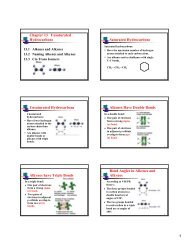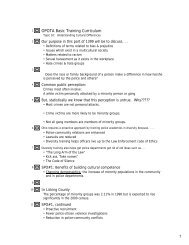Student Learning /Assessment Glossary
Student Learning /Assessment Glossary
Student Learning /Assessment Glossary
You also want an ePaper? Increase the reach of your titles
YUMPU automatically turns print PDFs into web optimized ePapers that Google loves.
<strong>Student</strong> <strong>Learning</strong> <strong>Assessment</strong> Steering Committee<strong>Student</strong> <strong>Learning</strong> /<strong>Assessment</strong> <strong>Glossary</strong>Revised 2-22-07Term or concept<strong>Assessment</strong>Analysis Outcomes (4)(Blooms Taxonomy level ofstudent thinking.)DefinitionCollecting and evaluating information about theperformance, knowledge or disposition of anindividual student, quality of the course, program orcollege. <strong>Assessment</strong> happens when the data areevaluated. Meaningful assessment of a continuousongoing nature guides program growth or change.Examples: Differentiate between two ideasListen and analyzeDiagram a problemApplication Outcomes (3)(Blooms Taxonomy level ofstudent thinking.)Behavioral goalsBenchmarkComprehension Outcomes (2)(Blooms Taxonomy level ofstudent thinking.)Core CompetenciesCourse Goals/objectivesExamples: Demonstration in lab of knowledgeApply principles ofComputeUse toolsUse concrete action words like describe, explain,evaluate that define a goal that is not too broad ortoo specific.A measure that compares to student peers or normreferenced.A specific component of skills orknowledge within academic content standards. Forexample: If complied results show 80% is higherthan the norm then the instructor decides if a changein teaching is advantageous.Examples: Classify a variety ofExplain the scientific method of inquirySummarize important aspects ofBasic skills, knowledge and dispositions expectedfor all graduating students regardless of programmajor.COTC General Education Core includes:Develop knowledgeDevelop technical skillsDevelop self relianceDevelop a sense of responsibility as a citizenWhat the student will know or perform by the end ofthe course with specific objectives of how thestudent will meet the course goals.1
Direct MeasuresEvidenceFormative evaluationEvaluation Outcome (6)(Blooms Taxonomy level ofstudent thinking.)High Stakes testingIndirect MeasuresEvidenceInstitutional EffectivenessRelates directly to the student’s knowledge or skills,like a portfolio of skills, direct observation in lab orclinical.Usually conducted during instruction to provideinformation on student learning. Informs the teacherof effectiveness of the materials and instruction.Teachers can adjust their teaching and make changesif needed.Examples: Make comparisonsCritique and assessMake conclusions based on experienceState personal reasons with experienceTesting results are used to make major decisionsabout the student’s future like certification examsMeasures that make inferences about learning butdoes not demonstrate actual leaning like coursegrades, placement data, pre and post scores.How the institution is meeting its mission goals.<strong>Student</strong> learning is the heart of this effectiveness.<strong>Learning</strong> Outcomes(objectives, goals, and standards)Knowledge outcomes (1)(Blooms Taxonomy level ofstudent thinking.)Objectives(Goals and Outcomes)Performance Indicators(standards, criteria, rubrics,outcomes)PortfolioWhat the students are expected to know, performand maintain by the completing the degree programExamples: To describe the basic componentsGive examples ofRecognize patternsExpected graduate accomplishments which mayinclude life long learning values and focus on thefirst few years after graduation.Specific, measurable statements identifying theperformance required to meet the outcome,confirmed by evidence.A collection of work over time that reveal thestudent’s progress and learning outcomes. The useof the portfolio should be determined with specificentries and ways to evaluate the entries. Rubrics areoften useful for portfolio evaluations. <strong>Student</strong> selfassessments are often part of the portfolio process.2
Program Goals Goals that may or may not be required by anaccrediting body related to a particular field. Goalsthat are evident in the plan of study and carried outthrough the courses assigned on the plan, thereforeall faculty should be aware of these goals.ReliabilityRubric<strong>Student</strong> <strong>Learning</strong><strong>Student</strong> <strong>Learning</strong> <strong>Assessment</strong>Steering Committee (SLASC)Summative evaluationSynthesis Outcome (5)(Blooms Taxonomy level ofstudent thinking.)ValidityThe degree to which an assessment measuresconsistently across different types of measures, forexample with various raters, times or sets of testitems.A grading guide with a scale of descriptions thatdefine qualitative characteristics for a particularassignment.Acquiring knowledge, skills and dispositions as aresult of experience within a course, program orcollege. To develop metacognitive skills (To thinkabout their own thinking and what they are learning)and take responsibility for their own learning.A faculty –based committee developed to provideoversight of assessment of student learning incompliance with accrediting bodies of the CollegeUsually collected at the end of instruction within aset cycle to evaluate student’s knowledge of theobjectives and the instructor’s effectiveness.Usually for establishing a grade. Usuallyadjustments in the instruction are for the next timethe class is taught.Examples: Revise work to find errorsFormulate a hypothesesCreate something, like art workThe accuracy of an assessment measurement, itmeasured what it intended to measure.Interpretations and decisions are often supported byindependent evidence or analysis of scores.3




